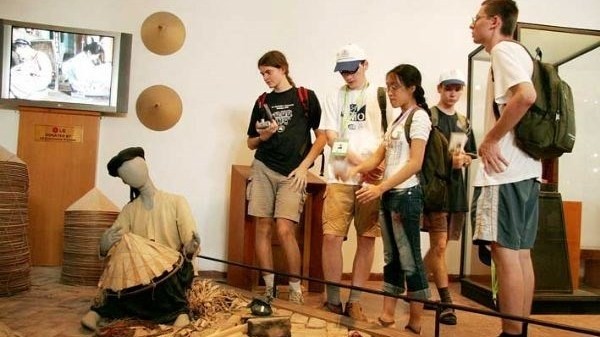The three museums include the Vietnamese Women’s Museum, the War Remnants Museum and the Vietnam Museum of Ethnology (VME).
The key to the three museums’ success lies not only in a change in the organisation of the displays, but also in a shift in the curators’ approach to the role and function of museums.
In recent years, many major museums in Vietnam have hosted grand exhibitions to attract more visitors. However, the outcomes of these events have not met the museums’ expectations.
Once a year, the National Museum of Vietnamese History makes public a part of its collection of valuable objects for several months. The exhibits include royal seals dating from the feudal regime, ceramics, and ancient lamps. However, these displays only attract the interest of visitors during the opening week.
VME former director, Associate Professor Nguyen Van Huy said that the success of a museum is dependent on its exhibitions and, even more importantly, activities promoting its exhibits. The museum should figure out how to make their exhibitions more attractive while digging for further information on the exhibits to connect them through a story.
The exhibitions should also relate to pertinent life and community issues to draw visitors’ interest.
Huy pointed out that many museums are showcasing their collections in an ineffective way — the museums are displaying as many objects as possible but with limited information.
Visitors are asking for more in depth information instead of short and perfunctory legends. Instead of cramming hundreds of objects into a small room, it would be better, and more effective, to showcase just 20% of them, but with full information provided.
For instance, it is common to see an abundance of Vietnamese soldiers’ iron helmets penetrated by many bullets at a military museum. But in Huy’s opinion, the organisers should “tell a story” about a specific helmet: whom it belonged to, a short biography of the soldier, and the context in which he or she died. Or the helmet can be displayed separately in a window lit by special light focusing on the holes on the helmet, increasing the poignancy of the object and stirring the sentiments of visitors.
As another example, Huy said that it is popular to see large pictures of provincial leaders at local museums. He suggested that the leaders should be remembered through a specific detail, a quotation or a construction project they were involved in.
Meanwhile, the three museums that were recommended by Trip Advisor always find their own innovating approaches to displaying their collections. At a recent exhibition on Dao Mau (Mother Goddess) and Hau Dong (Mediumship), the Vietnamese Women’s Museum utilised videos and clips on the personal lives of the women who took part in the traditional cultural practice.
The War Remnants Museum, despite recalling war crimes in history, choses to focus on the good, rather than evoking animosity or resentment.
Many researchers agreed museums in Vietnam currently have an unclear approach to the distinction between communication and education. Most curators are more focused on communication and less focused on the education side of museums., Many museums organise their exhibitions in a very rigid way, thus losing out on a large number of potential visitors from surrounding schools.
In addition, most schools entrust travel companies to arrange museum trips for their students. It is difficult to evaluate whether the students are learning new things from the museum, or if they just consider it to be a fun outing.
While working as the VME director, Huy made the unprecedented decision to provide discounted tickets for groups of less than 300 visitors, and free tickets for groups of 50 students and under. The programme was highly appreciated by UNESCO and cultural experts.
Explaining the programme, Huy said that it is focused on attracting school boards who bring their students to the museum with the aim to provide them with a real classroom experience, rather than fulfilling a requirement from the education sector.
There is a need for a shift in thinking to make museums more attractive for visitors at home and abroad.
“For many years, many people have thought of museums as a sacred and solemn place,” Huy said.
“However, I think different. A museum should not serve as a worshipping place but a meeting place for the community to look at the daily life,” Huy concluded.
















